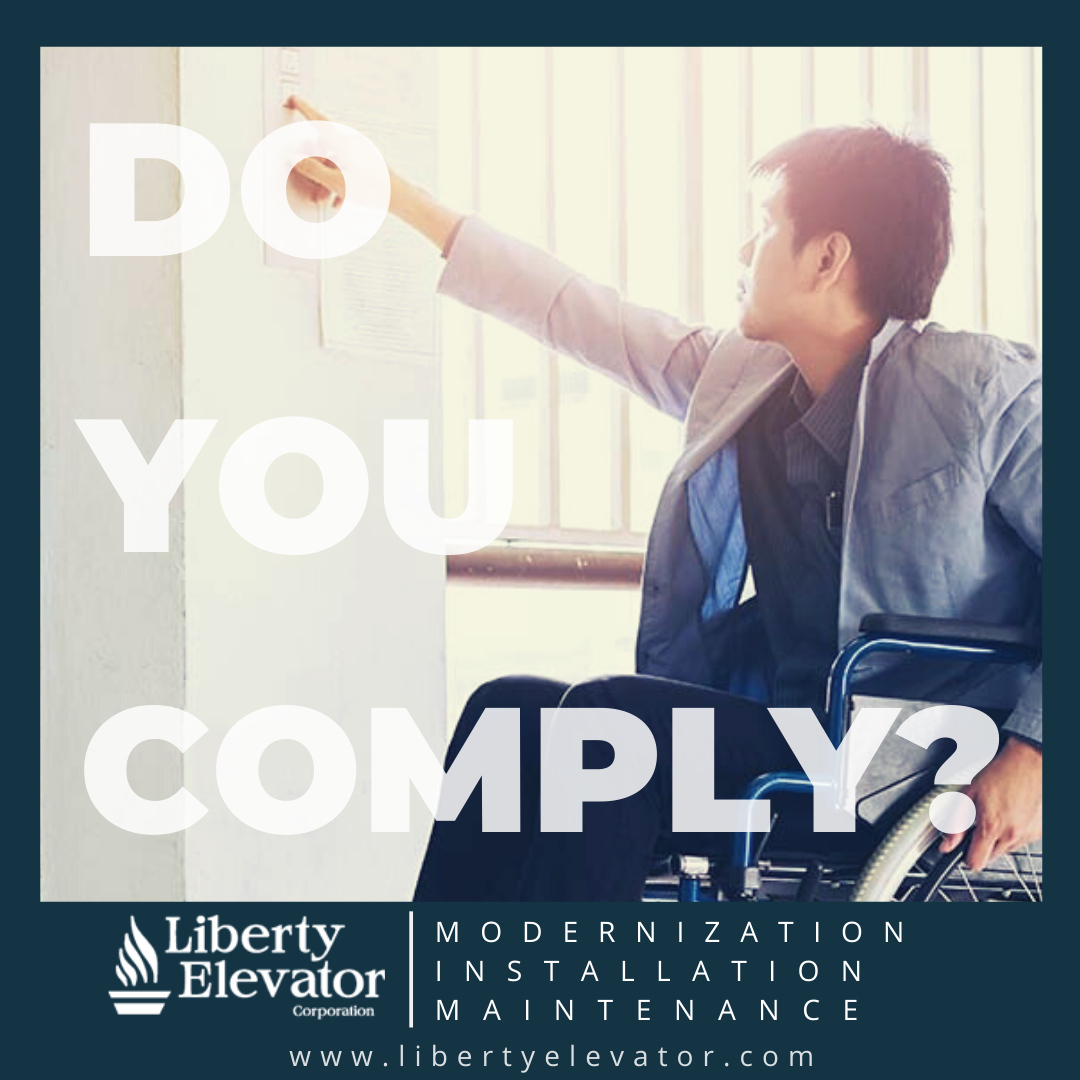
The Americans with Disabilities Act (ADA) legislates requirements for elevators that building owners need to know when planning new construction or when renovating existing structures. Every building must have at least one elevator that meets accessibility requirements. If you are unsure whether or not the elevator units in your building are compliant with the ADA’s regulations, review the following information in order to gain a better understanding of compliance procedures.
Elevator ADA Requirements & Terminology
Two vital terms to know when talking about the ADA's standards for elevators are "public accommodation" and "readily achievable", which are defined as follows:
- Public Accommodation: A private entity holding, leasing or operating public facilities such as public spaces for recreation, rental locations, hotels and facilities for lodging. This also includes stores, restaurants, shopping malls, hospitals, specific offices, and other types of public areas.
- Readily Achievable: This term refers to modifications that can be easily accomplished with little to no inconvenience or cost. The factors defining the readily achievable state involve the type and cost of the adjustment as well as the financial means of the owner.
According to ADA requirements, if a public accommodation can make adjustments in a readily achievable manner, they are obligated to make such changes in order to make the area as accessible as possible.
ADA Provisions for Commercial Elevators
In addition to understanding key terms involved in determining what entities are obligated to change and what conditions mandate adjustments, property owners may want to review the following list of ADA provisions specifically for elevators to be aware of requirements for their units.
- All elevators should operate electronically. Specifically, all elevator doors must open and close automatically and have a reopening feature to stop and reopen the elevator door immediately if a passenger is entering the elevator without physical contact.
- All call buttons in elevators are centered at 42 inches above floor level, have a minimum diameter of .75 inches and are required to be illuminated at all times. Buttons must feature visual signals to display when each call is recorded and answered.
- All elevators must have control features such as buttons, visual, tactile, and braille control designators.
- Braille plates are also required on all entrance jams as well as hall stations.
- The minimum amount of time elevators doors must stay open for entry is 3 seconds.
- The floor area of elevators should be large enough to provide ample space for a wheelchair user to enter the unit, reach controls, and safely exit the elevator.
- Hall signals must be both visible and audible, provided at each entrance to show which elevator is answering the call. Audible signs must signal once for ascending directions and twice for the descending directions or provide a verbal signal stating up or down.
- Handrails are required at certain heights, standard of 30 inches.
- Two-way communication in the elevator cab is required. This form of communication must be available for use by both by deaf and blind persons. This means that the communication should be both tactilely and visually accessible and understandable.
- Emergency control buttons should be grouped in an accessible, centralized area of an elevator’s control panel.
- It is essential that elevators are easily accessible to visitors in all public places. This calls out for their placement to be in areas that people can get to without excessive inconvenience.
ADA Standards for Accessible Design
In 1990, The Americans with Disabilities Acts set forth 'Standards for Accessible Design' for all new buildings and building alterations. These codes were updated in 2010. The premise behind the regulations is that all buildings should be accessible to people with disabilities.
The Department of Justice’s revised regulations for Titles II and III of the Americans with Disabilities Act of 1990 (ADA) were published in the Federal Register on September 15, 2010. These regulations adopted revised, enforceable accessibility standards called the 2010 ADA Standards for Accessible Design, "2010 Standards." On March 15, 2012, compliance with the 2010 Standards was required for new construction and alterations under Titles II and III. March 15, 2012, is also the compliance date for using the 2010 Standards for program accessibility and barrier removal.
2010 ADA Standards for Accessible Design:
https://www.ada.gov/regs2010/2010ADAStandards/2010ADAstandards.htm
Elevator Accessibility Experts
Installation of an elevator in a building is a formidable task, and it is crucial to comply with all existing local building codes and federal and state regulations. It doesn't matter if you're installing a brand-new elevator in a new building or if you are retrofitting an old one into an already existing space. It is important that you follow all the possible steps towards making your elevator compliant with existing codes.
After 60 years of successful growth in the New York Metro area, Liberty Elevator Corporation has expanded it's elevator service reach to include South Florida. Now providing Miami, Fort Lauderdale, Palm Beach, Naples and the surrounding area with certified union elevator mechanics to perform maintenance, modernizations & new elevator construction in the commercial real estate market.
Whether choosing a customized elevator maintenance program, installing nonproprietary equipment, or providing a flexible agreement, Liberty Elevator provides knowledgeable recommendations for various models and vintages of elevator equipment.
If you are unsure of your elevators’ ADA requirements or currently have violations, please contact Liberty Elevator today and we will be happy to survey your vertical transportation plan and assist you with improving your building's ADA compliance. Our goal is a more accessible world for all.

